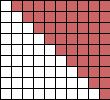Answers to Problems
Page 120:
Take a pair (m/n) in the sequence for √2, where n is even, so m2 − 2 n2 = 1.
Then ((m − 1)/2 + n, (m + 1)/2 + n, m + n) is a Pythagorean triple with two sides differing by 1.
 | The picture immediately gives the explanation of how to add the numbers from 1 to 9. Two such triangles make a rectangle of 9 × 10 squares, and half of this is 45. To add the numbers from 1 to 100, take half of 100 × 101, which is 5050.
|
Page 121:
If the triangular number s(s+1)/2 is square, then either s+1 is square and s/2 is square, or s is square and (s+1)/2 is square.
These are equivalent to taking s = m2 − 1 when
m2 − 1 = 2n2, and
s= m2 when m2+ 1 = 2n2.
We know the solutions to these equations from the approximations to √2.
Thus the sequence of possible numbers s runs:
12, 32 − 1, 72, 172 − 1, 412, 992 − 1...
where the numbers 1, 3, 7, 17, 41, 99... come from the approximations to √2.
These give the triangular numbers 1, 36, 1225, 41616, 1413721, 48024900...
|